Since DxOMark sensor scores strongly depends on sensor noise and dynamic range, both of which are strongly influenced by sensor size, it is not surprising that larger sensors scored higher than smaller ones. This said, we found interesting differences even between drone cameras with similarly-sized sensors. And for reference, we also provide some comparisons with standalone cameras with similar-sized sensors.
Why use DxOMark sensor scores for drone cameras?
A drone is your eye in the sky. And that eye is only as good as the camera it carries. At DxOMark we specialize in measuring the image quality of sensors, lenses, and mobile devices – so naturally we want to help you evaluate the image quality of drone camera sensors. We begin by testing several models of drones that are popular with photographers. Our focus is on the native image quality coming out of the sensor in its purist form – in other words, the RAW files.
Our use case scores highlight different performance metrics covering different user experiences:
- Our Landscape score evaluates the overall dynamic range a camera can capture. For high-contrast outdoor scenes, you’ll want as much dynamic range as you can get to capture details in both lit and shaded areas.
- Our Sports score is an indication of how well a camera performs in low light – or at the high ISOs often needed to capture fast action. So the Sports score is particularly important if you are flying at dusk or dawn, or capturing live events with lots of action. Of course, as for other camera type, it is worth noting that there are other attributes to take into account, such as image stabilization, that our sensor score doesn’t take into account.
- Our Portrait score is a guide to the color depth and definition that a camera captures. Architectural photographers will find this score particularly relevant, as will those using drones to detect subtle defects or other issues as part of industrial applications.
DxOMark Sensor score measures only RAW sensor image quality
Raw sensor output is only one part of evaluating overall drone camera quality. There are a number of other factors that come into play for still photography, and of course for video, that DxOMark does not measure.
For still photography, white balance, exposure, frame rate, and stabilization are all important. For videographers, additional variables come into play, including recording resolution, electronic rolling shutter or flight-path programmability, encoding and compression, and stability of imaging settings as the scene changes.
Flexible maneuvering of the camera from the ground is also important in some applications. Finally, for real time applications such as drone racing, the quality and latency of broadcast preview images is critical.
Use cases for DxOMark sensor scores in drone photography
Landscape and Architectural photography
For drone cameras, our Landscape (dynamic range) score is directly applicable to outdoor photography in good light. Since most aerial landscape shots include both brightly lit and shaded areas, more stops (EVs) of dynamic range means that more detail can be preserved in both the shadows and the highlights. Color detail, as measured by our Portrait score, is also very important for ascertaining a camera’s ability to capture subtle color differences in natural scenes.
Both of those scores are also important for architectural and industrial photography applications, where detail preservation and color rendering play an important role.
Night photography
Night time aerial shots are both popular and difficult for drone cameras to capture. They have all the challenges of daytime photography along with the need for higher ISO settings to deal with lower light levels. Our Sports score is very helpful here, as it measures the drone’s ability to operate effectively in low-light situations while maintaining a sufficient shutter speed.
Tradeoffs in designing a drone camera
As much as photographers are known for complaining about the weight of their gear, an ounce or two here or there typically doesn’t make much difference. For drones, it is an entirely different matter. Their limited carrying capacity and battery size mean that each additional ounce of payload either increases the size and cost or decreases flight time. As a result, the choice of camera is not only affected by the usual budgetary considerations, but by tight physical tradeoffs. Larger, heavier, cameras also require larger and heavier gimbaling mechanisms. Similarly, some models feature more-expensive airframes that allow the camera to view 360-degrees without obstruction.
This tradeoff is most obvious when looking at the sensor size of various drone cameras. If all other things are equal, a larger sensor provides for either more resolution or better low-light sensitivity – or both. But it also increases the size and cost of the optics needed, in addition to the increased cost of the larger sensor. Stabilizing a larger camera module is also more difficult. So when we go through the details of the drone cameras we reviewed, we’ll compare them both to drones with a variety of sensor sizes, as well as to standalone cameras with the same sensor sizes.
Another important tradeoff is modularity. Drones with integrated cameras can be smaller and lighter, but don’t provide flexibility in swapping out or upgrading camera modules. In the drones we reviewed, you can see these tradeoffs in action by looking at the difference between the Phantom 4 Pro’s integrated 1”-format sensor and the Zenmuse’s modular micro-4/3. The entire Phantom 4 Pro sells for about $1500, while the Zenmuse X5 S camera alone costs $1800 and requires DJI’s $3000 Inspire 2 drone to fly it.
Our drone camera reviews in more detail
Since we are using our DxOMark Sensor tests to evaluate these drone cameras we can compare their still image quality to each other and to that of standalone cameras with similar-sized sensors.
DJI Zenmuse X5 S drone camera (74)
DJI’s Zenmuse line of cameras feature micro-4/3 format photo modules combined with a custom gimbal. They are designed to be mounted on the company’s high-end Inspire line of drones. The Zenmuse X5 S is used with the newer Inspire 2 model. It features 21MP resolution in a 4:3 aspect ratio, recording 16 bits per pixel. It also has support for on-board bracketing, making ideal for applications requiring HDR. Videographers will appreciate that it can record 5K video at 30fps.
Our measured dynamic range of 12.7 EV is a close match for DJI’s own advertised number, and is excellent for a smaller-than-full-frame sensor. Similarly, its 23 bits of color depth are very good. Its low-light score of 956 ISO is good compared to most of the drones we have tested, but not great when compared to standalone cameras with a similar-sized sensor.
Since it has the largest sensor of the drone cameras we tested, it isn’t surprising that its scores came out ahead of the others. Comparing it to a current model standalone micro-4/3 camera (with the same size sensor) shows that there is still room for improvement:
DJI Zenmuse X4 S drone camera and DJI Phantom 4 Pro (65)
The Zenmuse X4 S has a smaller, 1”-format sensor and a lower price tag than the X5S. It is the same size sensor used in the Phantom 4 Pro, so it isn’t surprising that the two models have virtually identical scores. Both measure 22 bits of color depth, but the X4 S comes out a tiny bit ahead in dynamic range. with 12.6 Evs versus 12.5, and a tiny bit behind in low light, with an effective ISO of 442 versus 466.
The unit’s specs are also very similar, with both featuring 20MP resolution in a 3:2 aspect ratio, and an ISO range of 100-12,800. The Zenmuse has the advantage in maximum frame rate, at 20 versus 14, but both units have the same support for bracketing. The Zenmuse can output 4K video at 60fps, while the Phantom 4 Pro is limited to 50fps.
As with the X5 S, we can see that there is still room for improvement in performance for a sensor of this size by comparing these drone cameras to the popular Canon G7 X compact camera, which also features a 1”-format sensor. The Canon has the edge in all three score categories for an overall DxOMark of 71:
DJI Phantom 4 (48)
The Phantom 4 has a lot in common with its slightly more expensive Pro sibling, but its specs are definitely weaker. Its sensor is a smaller 1/2.3-inch version with 12MP resolution and a 7fps maximum frame rate. It records video at 4K, rather than at 5K. Not surprisingly, the Phantom 4 also scores a little lower across the board than the Pro version, giving up about 2 bits of color depth, with a measurement of 20.4 bits, and about half an EV of dynamic range at 11.8 Ev. The biggest difference is in its low-light score of 128 ISO, compared to the Pro model’s 466.
If you are looking to save some money and to fly during the day, the Phantom 4 may be a good choice for you. But if you need high performance in low light, then the Pro model offers a substantial advantage in image quality.
GoPro HERO5 Black (Karma drone) (38)
The GoPro HERO5 is a popular action camera that is also the heart of the company’s Karma drone. Showing that sensor size isn’t everything, the HERO5 Black scores measurably below the Phantom 4, even though it has an identical-sized 1/2.3-inch 12MP sensor. It also records only 10 bits per pixel. For video, it has almost 4K recording capability (3840 x 2160), but only at 30fps.
On image quality, it falls slightly lower across the board than the Phantom 4, with 19 bits of dynamic range, 11.2 EV of color depth, and 105 ISO for its low-light score. When compared to a standalone camera with a similar-size sensor such as the Pentax Q10, it shows that here, too, there is plenty of room for future improvement:
Of course, what you get in exchange for trading off a bit of image quality is an interchangeable, popular action camera that you can use for a variety of other things when it’s not on your drone. If you already own a HERO5 Black, you can also save by purchasing GoPro’s Karma drone with only the harness.
Note that GoPro recalled its initial Karma drones, but has since fixed the issue and is beginning to sell them again in limited numbers.
YUNEEC Breeze 4K (35)
YUNEEC makes a wide variety of drones, but for those who want to get a taste of aerial photography without spending a lot of money, the Breeze 4K may be appropriate. Its smartphone-sized sensor contributes to making it the lowest-scoring drone camera we tested, but it is also by far the least expensive — $400 for the drone, including the camera. Since it crams 12MP of resolution and 4K (actually 3840 x 2160) recording into a 1/3.06-inch smartphone-sized sensor, you can expect photo results similar to a high-end mobile device.
While the Breeze 4K’s scores are lower across the board than the other drone cameras we tested – 19 bits of color depth, 10.7 EV of dynamic range, and a low-light score of 69 – they are well-balanced and should provide reasonable results under good lighting conditions. Note that the Breeze camera is fixed-mount without a gimbal, so you need to control the drone itself to change the camera angle.
YUNEEC has done a good job with its small sensor, and the Breeze holds up well against a top-of-the-line smartphone with a similar-sized sensor:
Conclusion
Just as with standalone cameras, sensor size plays a key role in image quality for drone cameras. But the unique size and weight tradeoffs of aerial photography mean that bigger isn’t always better for a particular application. Costs also increase with the size of the sensor, so those on a budget may find they can make do with less than top-of-the-line image quality, depending on their needs.
It’s also clear that for each size sensor, standalone cameras have been able to push performance somewhat further than that found in current drone models. This means we should expect to see continued improvements in quality as drone camera designs catch up to the decades of experience that makers of more traditional digital cameras have had. Choosing a modular system with a separate camera is one way to help insure you can take advantage of future developments, but it might be more expensive in the short run.


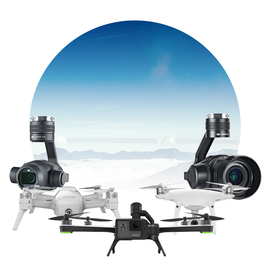
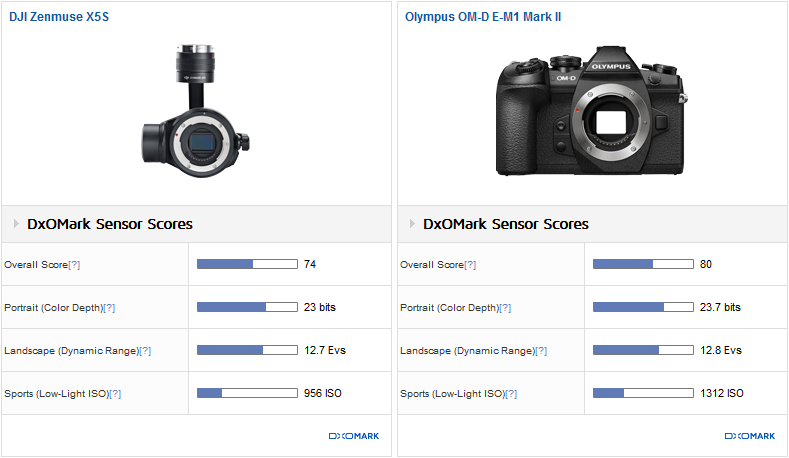
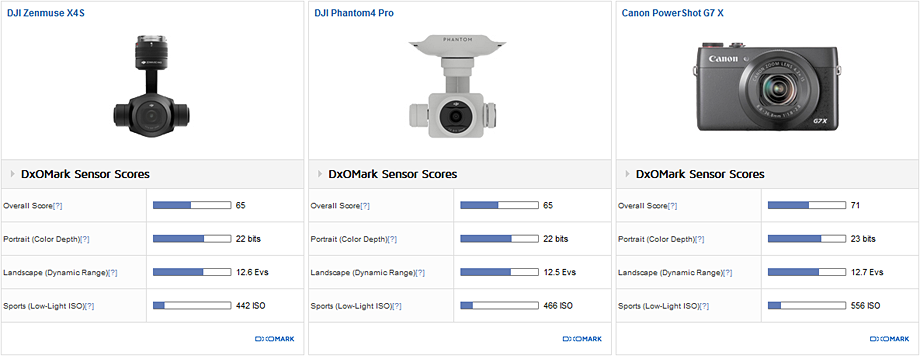
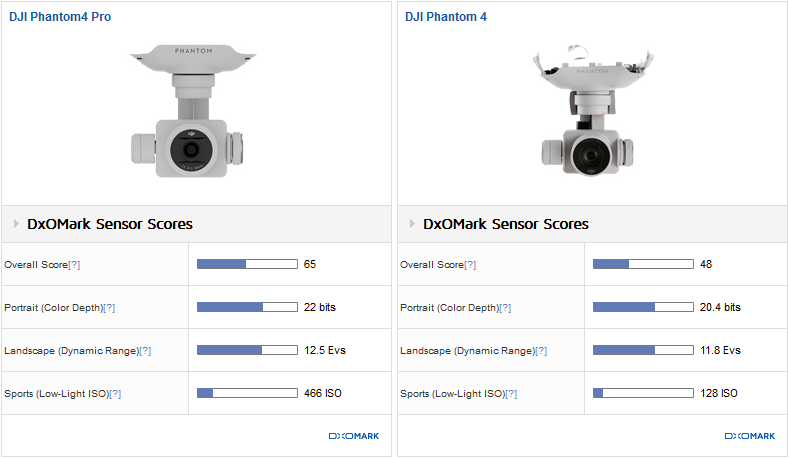
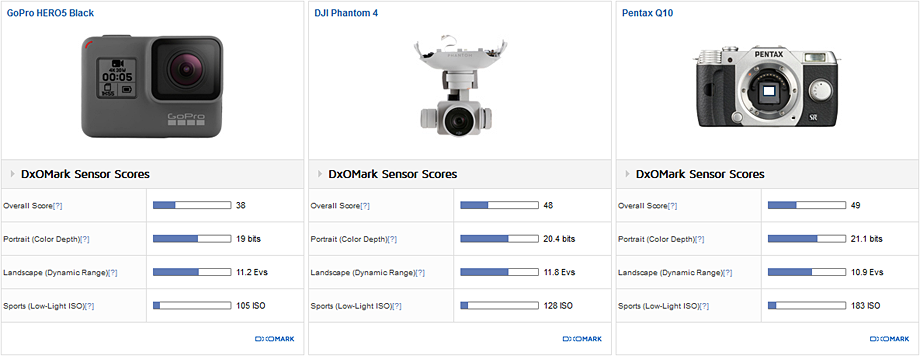
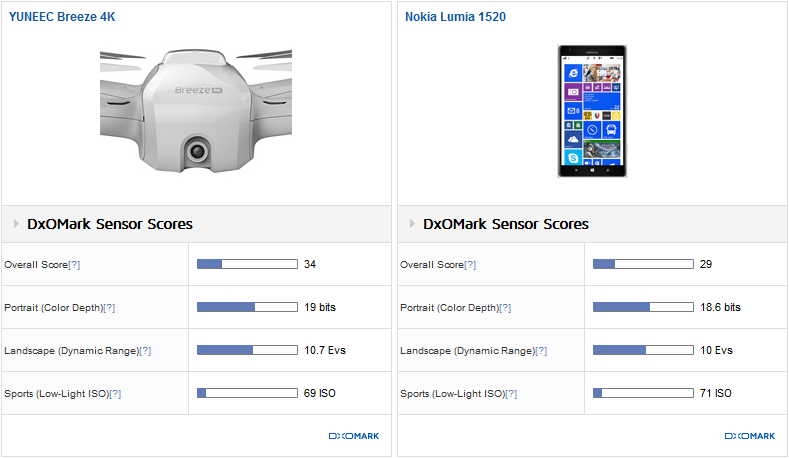
DXOMARK encourages its readers to share comments on the articles. To read or post comments, Disqus cookies are required. Change your Cookies Preferences and read more about our Comment Policy.